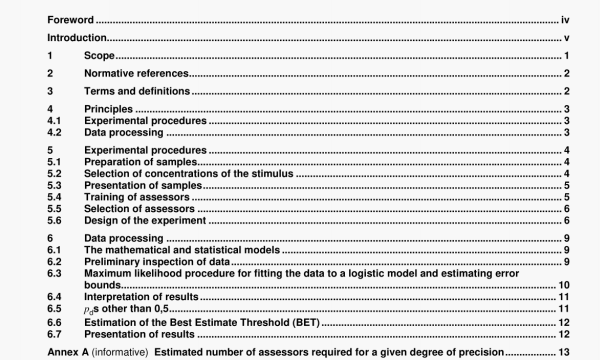ISO 13301 pdf download – Sensory analysis -Methodology -General guidance for measuring odour,flavour and taste detection thresholds by athree-alternative forced-choice (3-AFC)procedure.
Observe that Ld increases linearly with stimulus intensity if P conforms well to a logistic ogive. At this point, decide whether to complete the calculations using transformed or untransformed data. The untransformed graph of Pc versus log . is almost linear in its middle range, and for the purpose of locating the weshold. which is the point where Pc = 2/3, the transformation provides little advantage over an ogive fitted by eye or a straight line titled numericaly to the middle range Otp data.
On the transformed scale, the threshold is the log concentration at which L -0. Estimate its value from a straight me tilled visually or by fitting a linear regression line numerically. Note that transformed values near the asymptotes can be erratic because small changes in the proportions in these regions have Large eflects. Hence, ignore values of below 0,43 or above 0,9 (transformed values of L,d below – 1,75 or above 1,75) when titling the me to the plot, unless the interest of the experiment is in this region, see 6.5. Note also that the transformed graph permits a direct interpretation of the parameters of equation (3) as this is the stimulus intensity (in log concentration) at which Ld = 0 while b.s the slope of the straight line.
6.3 Maximum likelihood procedure toe’ fitting the data to a logistic model and estimating error bounds
6.3.1 General
The princqle of the ML procedure for fitting the logistic model is to find those values of the parameters i and b for which the data are more likely than for any other values of the parameters. The procede may be carried out and the error bounds estimated with the aid of one of the proprietary computer programs written for the purpose2), or perhaps more conveniently, by making use of the computer spreadsheet procedure described in Examples 8,2 to 8.4. The ML procedure finds, e.g., the upper bound as a value of t such that there is a probability of 0.05 of the estimate being greater than this.
6.3.2 The parameter b
This determines the steepness of the fitted line. For an individual assessor, it indicates lineness of discnminatbon for changes in stimulus intensity and is related to indices like the Weber ratio or the exponent in Stevens’ power law. Individuals chtler in b as they do in threshold and its value or distribution in the population may be of equal interest. Someone with a high value of b (a steep slope) is sensitive to small changes in intensity and might be particularly effective In tasks involving quality control or monitoring. Knowledge of an individuals b could be as important as of threshold when selecting assessors.
6.3.3 Confidence Intervals for estimated parameters
The confidence interval for an estimate can be thought of as a range of values within which the true value might plausibly lie. The narrower the interval, the more confident we are about the estimate. The accuracy of the estimates can be improved by increasing the total amount of data and by choosing concentrations evenly spaced over a range of 0,25 x up to 4 x the threshold concentration.
Individual thresholds can be estimated from experimental designs in winch each assessor makes at least one trial at each Intensity, see Example 8.1. The experimenter can then calculate the mean mresholds as well as the group threshold from pooled data, and examine the distribution of thresholds, Note that the individual thresholds estimated from such a design will be very imprecise whale a pooled group threshold can have better precision. For example, a design incorporating two Iflals from each of 50 assessors at five intensities will provide 500 data points for estimation of the pooled threshold, but only 10 data points for estimating each individual threshold,
The group threshold from pooled data, and its error bounds, can be estimated from data derived from a design in which each assessor evaluates just one presentation at one concentration, but more often the design will require the assessor to make at least one trial at each concentration. Populations usually exhibit wide ranges of individual thresholds for a substance. For an individual, a 100-fold range of concentrations will typically span a range of Pci from 0.05 to 0.95, but the indivickial thresholds for a number of assessors can often span a 10 000-fold range of concentrations. A 100-fold range of concentrations presented to a groi of assessors will mean that for some assessors, perhaps a substantial number, the entire test range will be near one of the asyniptofes of that individual’s psychophysical function. Results near the asymptotes make little contribution to estimating , and h. hence in the case of pooled data, individuals with high or low sensitivities will have low weight wi estimating the parameters. If this is undesirable, pooling should not be used, or individuals of interest should be deliberately emphasized by asymmetrical weighting.
ISO 13301 pdf download – Sensory analysis -Methodology -General guidance for measuring odour,flavour and taste detection thresholds by athree-alternative forced-choice (3-AFC)procedure
